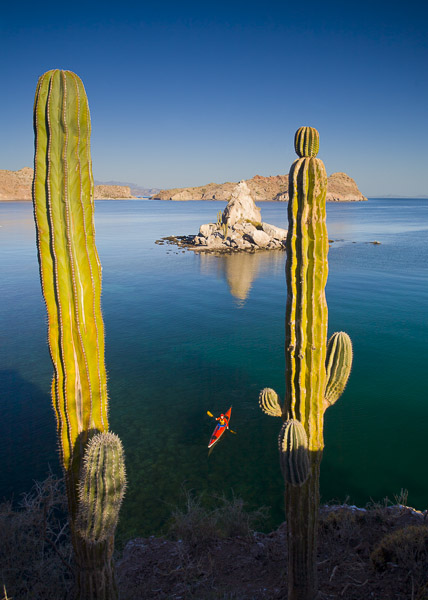
In the field, I often stalk through a potential photo op with the viewfinder glued to my eye, seeking just the right composition or perspective. If I plan well, I’m scouting before the light gets good—in the afternoon for a sunset shot, or the day before for the sunrise. What I’m scouting for is foreground.
With our binocular vision, the grand scenic is generally easy enough to see. But photographs are flat sheets of canvas; they need help. To find the help—or helping elements—takes a bit of work. So I find myself scanning for foreground, moving right or left, getting low, searching for elements that add context, depth, rhythm, frame, an anchor or a sense of place. Foreground elements do all these things, and without them the grand scenic before you is likely to fail.
An excellent strategy is to look, look, look. When you find a satisfying composition, don’t set up the tripod. No, no! Remember the spot, and keep looking! Yes, keep looking! You may discover even better foreground elements, an even better composition. If not, return to the one you’ve already scouted as the magic hour peaks.
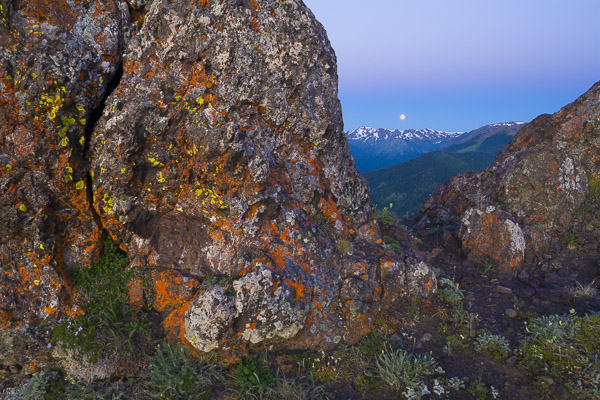
Finding foreground takes time and effort, a lot of it. Don’t give up until you find the frame, the context, the leading lines to match your vision. A paddling trip in Baja illustrates.
On the Sea of Cortez one winter, I searched every day for cactus close to the water’s edge to provide foreground for a kayaker. I wanted a shot that said desert, and that meant cactus. To include a kayaker, the cactus had to be close by. That cacti are nowhere near the tide line, either too high or too far away, complicated the search. I kept looking. Finally, I found a pair of gems one evening (Image 1), and returned in the morning to get the shot. The Cardon cacti perfectly frame the kayaker, add depth and texture, draw you into the scene. Photo editors like it, as I’ve sold this a few times, including as a magazine cover.
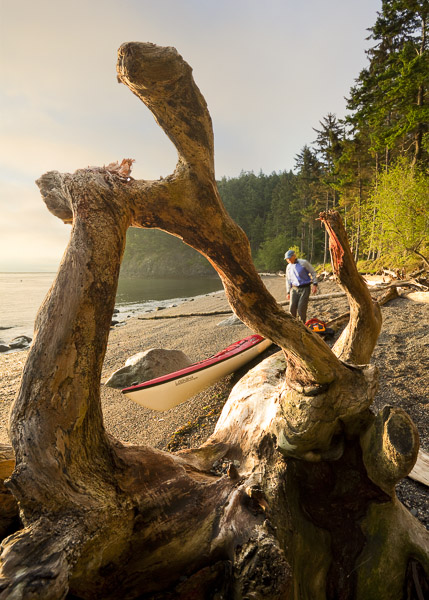
Sometimes when looking for that foreground element to anchor the image or lead the eye, you close in on it and find the foreground itself so engaging that it dominates; you decide it needs to be the subject. A good rule then is to fill the frame with it, but leave a bit of background that becomes the context or indicates location. In Image 2, I did just that, emphasizing the lichen-covered rock and adding just a bit of distant mountain (and moon). Beforehand I had tried framing mountains and moon using the rocks, but in the end the color of the lichen won out.
Image 3 is another framing example. I didn’t have to walk far to find this driftwood log on a beach at James Island (San Juan Islands, WA). I was immediately pleased with the peek-a-boo roots, and I hauled the kayak over to provide a subject. The curving wood draws a gentle frame that neatly divides the scene and adds depth. The soft texture of the grain draws you in. The strong diagonal works as well; I like the way it jut up into the sky.
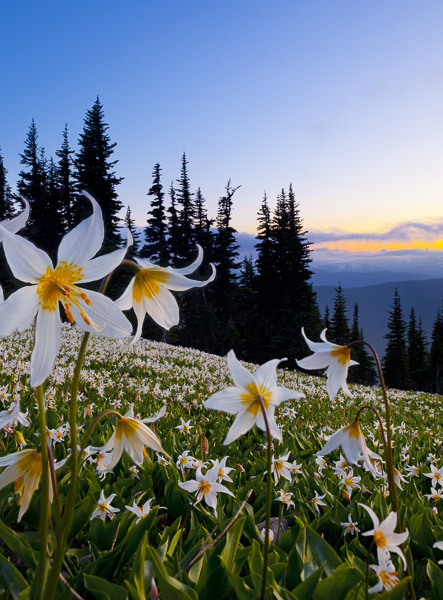
The summer wildflower season presents new opportunities for foreground, whether it’s frame-filling patterns or near-to-far, everything-in-focus, high depth-of-field landscapes. In Image 4, Avalanche Lilies carpeted an Olympic Mountains meadow. I framed up a few shots from high on the tripod, but the carpet of flowers looked uninteresting until I dropped down below the flower level, no easy task for 6- to 10-inch high flowers. I splayed flat the tripod legs and then got even lower by tipping the camera over for a vertical. I switched to live view because the camera was so low I couldn’t see through the viewfinder. I maneuvered the gear purposely, until I got a composition I liked. The close-in lilies provide a marvelous context, suddenly so tall, serenading the scene above the beat of the more-distant flowers. The foreground flowers anchor the image, provide intimacy, as well as draw you in to the scene.
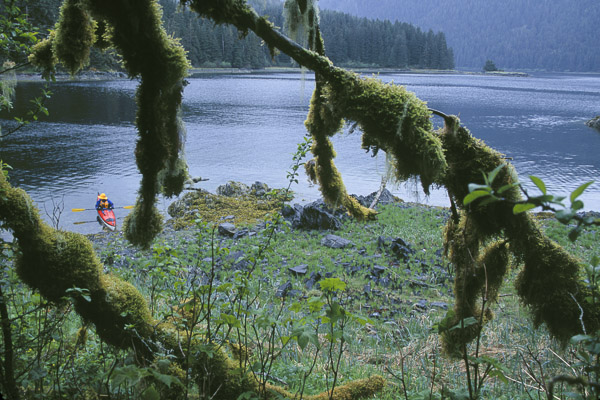
Image 5. In this SE Alaska bay, I didn’t find useable foreground at water’s edge, so I stepped into the woods, and quickly found a mossy frame of tree branches that add a sense of place. The pop of color from the kayaker draws the eye, led there by the strong diagonals of the frame.

Image 6. At Punchbowl Falls, Eagle Creek, OR, I placed a yellowed Big-leaf Maple leaf on a rock in the stream to provide a much-needed foreground element. The rock itself makes a subtle diagonal, leading the eye, and the leaf is perfectly angled, providing color, texture, context, even some complimentary lines. It says fall season in the Gorge, with a lovely flow of water over the Punchbowl Falls. I like, too, the repeat yellows in the background. They add a color rhythm to the foreground leaf. I truly enjoy this image; give me a scenic that makes me feel like I can reach out and touch the nature within.
Note: The images presented here were all shot with a wide-angle lens, from 17 to 35mm. Showing the big picture is a job wide-angle lenses are good at. They only need some foreground elements to put depth into the flat, two-dimensional canvas on which we paint with light. To get everything in focus, most images were created by stopping down the lens as far as f/22. An exception was the Avalanche Lilies, where I used a focus stack, thought I still used f/16. For the stack I shot one image focused on the foreground, and the second one focused on the background—to be finished later in Photoshop.
Gary
Very thorough, love the images, the foreground element examples are right on. Thanks
Gary, fantastic work! Thank you for inspiration and for all useful advices…
Thanks, Mikhail. Getting feedback was my top reason for building the new website.